Saint Therese of the Child Jesus
of the Holy Face
Entries in Mother Agnes of Jesus (3)
125 years ago with St. Therese: Therese writes the poem "To my dear Mother, the Fair Angel of my Childhood" - September 7, 1895
September 7, 1895 was the 34th birthday of Therese's sister Pauline, Mother Agnes of Jesus. As a gift for her sister's birthday, Therese wrote "To my dear Mother, the Fair Angel of my Childhood."
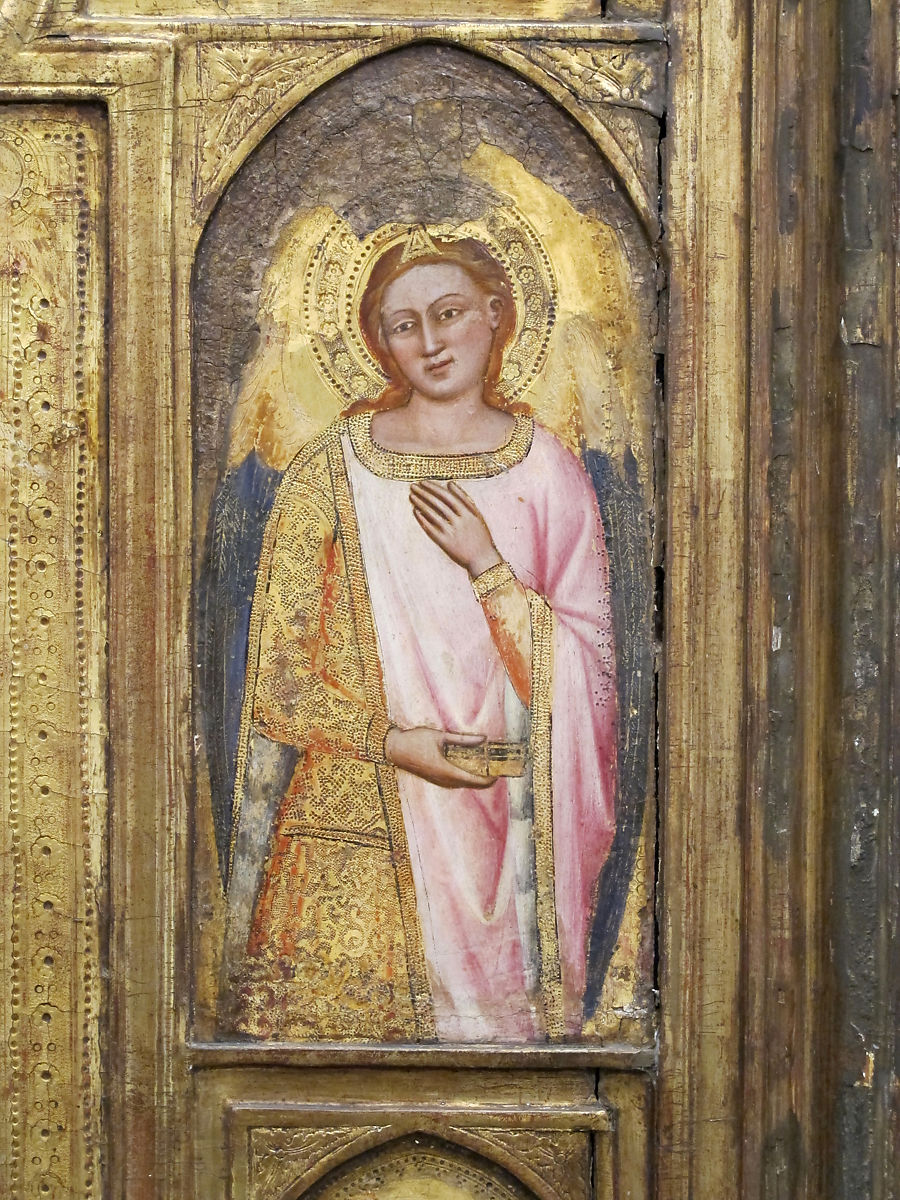 Detail from Jacopo di Cione, "Six Angels," Metropolitan Museum of Art, New York City
Detail from Jacopo di Cione, "Six Angels," Metropolitan Museum of Art, New York City 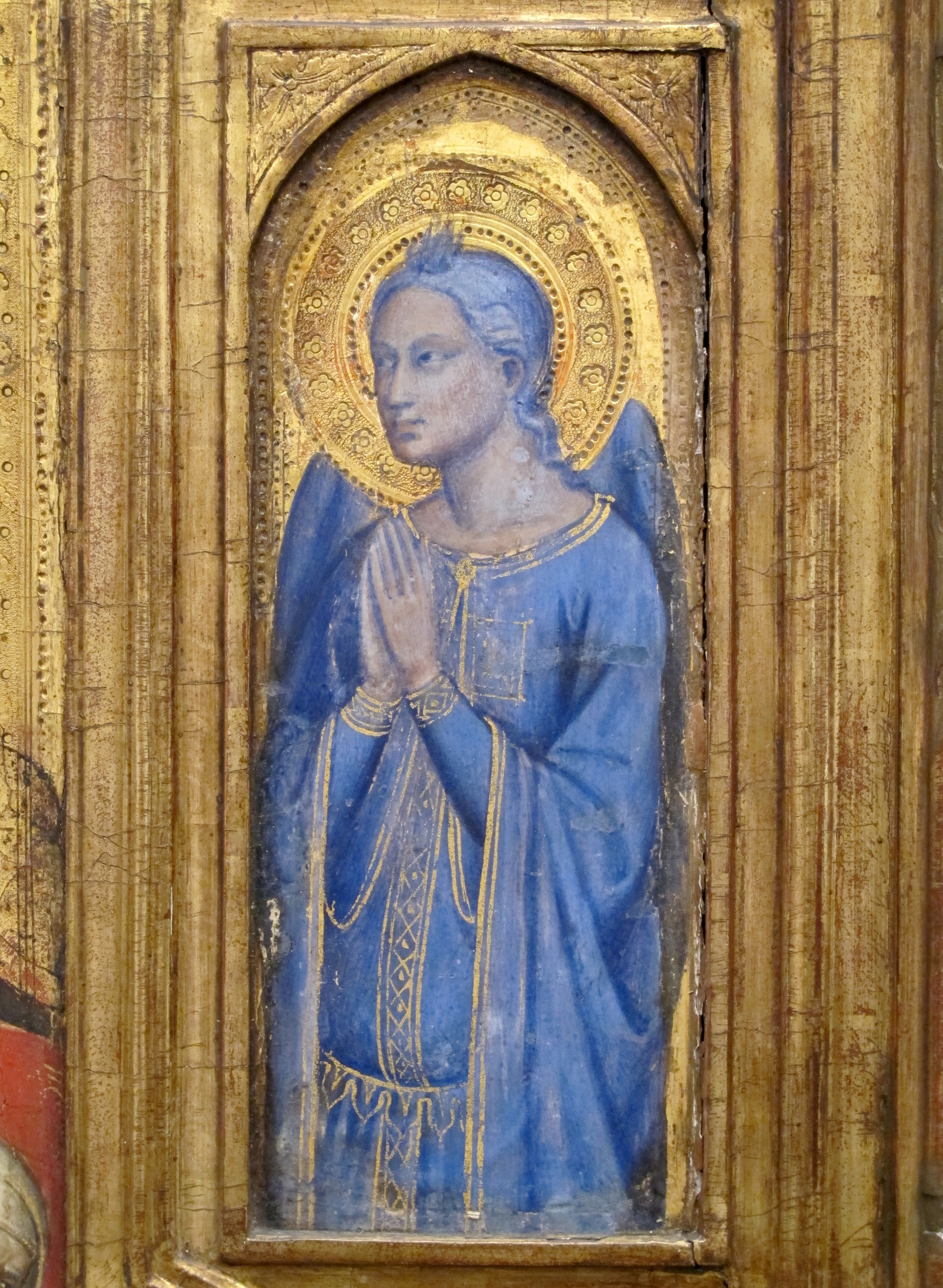 Detail from Jacopo di Cione, "Six Angels," Metropolitan Museum of Art, New York City
Detail from Jacopo di Cione, "Six Angels," Metropolitan Museum of Art, New York City
Mother Agnes had been serving as prioress for two and a half years, years of grace for Therese, who wrote that on the day of her election "Pauline became my living Jesus." The tenderness and gratitude that overflow in this poem were undoubtedly evoked by the fact that since January 1895 Therese had been writing her childhood memoir, a long letter to Pauline, which brought vividly before her Pauline's delicate and vital role in her life.
Therese depicts herself as a child and Pauline as the angel "who guides my steps," assigning to her sister the role of guardian angel. This angel sang of "the charms of Jesus," "the joy of a pure heart," the "beautiful blue Heaven," "the God of childhood" (a phrase that appears only here in Therese's writing), "the Virgin Mary." Tactfully Therese alludes only with the word "alas!" to the acute distress Pauline's departure for Carmel caused her, and dwells instead on her present happiness:
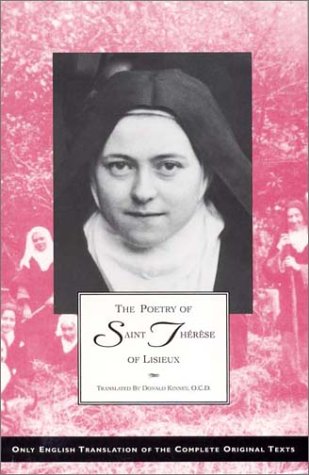
Letters from St. Therese's Sister Pauline, Mother Agnes of Jesus, to Sister Stanislaus of the Blessed Sacrament, 'Philadelphia's Little Flower' - Part 3, 1909-1911 - September 4, 2014
Read part one, "Sister Stanislaus of the Blessed Sacrament, 'Philadelpha's Little Flower'
Read part two, "Letters from St. Therese's Sister Pauline, Mother Agnes of Jesus, to Sister Stanislaus of the Blessed Sacrament, 'Philadelphia's Little Flower,' 1902-1909."
Read "St. Therese of Lisieux and Sister Mary of St. Joseph," which recounts the efforts of Sister Stanislaus’s childhood friend and fellow apostle, Sister Mary of St. Joseph, to make the spirituality of St. Therese known and loved.
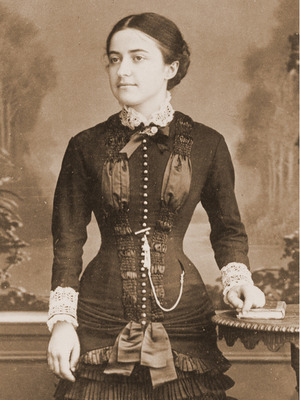 Mother Agnes of Jesus (Pauline Martin) as a laywoman. Photo credit: Web site of the Archives of the Carmel of Lisieux.
Mother Agnes of Jesus (Pauline Martin) as a laywoman. Photo credit: Web site of the Archives of the Carmel of Lisieux.
In the later years of the correspondence between Mother Agnes of Jesus, St. Therese's sister Pauline, in Lisieux and Sister Stanislaus of the Blessed Sacrament in Philadelphia, St. Therese's popularity was increasing dramatically. From July 1908 to July 1909, the Carmel of Lisieux had received more than 9,000 letters about Sister Therese from all five continents. Steps were being taken to introduce her cause. On May 8, 1908, Mother Marie-Ange of the Child Jesus, a saintly young nun who was wholeheartedly devoted to following St. Therese, was elected prioress of the Lisieux Carmel. That same day she wrote to the local bishop asking him to open an inquiry into the life and virtues of Sister Therese of the Child Jesus. On October 15, 1907, Bishop Lemonnier asked the Carmelites to write down their memories of Sister Therese of the Child Jesus. In Part 2 of this article, we had left Mother Agnes and Sister Stanislaus in January 1909. That very month Father Rodrigo of St Francis of Paola, a discalced Carmeite friar, was appointed postulator of the Cause, and Mgr Roger de Teil, canon of Notre-Dame Cathedral in Paris, was appointed vice-postulator.
About this time Sister Stanislaus sewed an outfit for the small statue of the Child Jesus that stood in the cloister of the Lisieux Carmel and which had been the special care of Sister Therese of the Child Jesus. On March 31, 1909, Mother Agnes wrote to Sister Stanislaus in Philadelphia to assure her that she had touched the robe to the statue of the Child Jesus and also to the statue of the Virgin that had smiled on Therese as a child: 'I have asked him to bless and kiss his little seamstress."
Again, as in her letter of July 17, 1903, Mother Agnes uses language suggesting that Sister Stanislaus has asked to see Therese's unpublished writings:
My dear child, regarding the pages of which you speak; you will read them only in heaven … but have patience, the exile is short. You will come up there into your little family. You are part of it, and there you will learn so many things! May it suffice you in this world to know that Thérèse has suffered much and has loved in proportion.
Mother Agnes acknowledges a gift from a friend of the Philadelphia Carmel and says that she can't fill an order for more rose petals or for certain books: "We do not have one single copy. All our books really have wings." Less than a dozen years after the death of Therese, the demand for souvenirs and writings was overwhelming.
Meanwhile Therese showed her affection for the Philadelphia Carmel. In this spring of 1909, Mother Gertrude had an attack of pneumonia complicated by heart disease. She received the Sacrament of the Sick. The community made a novena to Sister Therese for her cure. On the last day of the novena, Mother Gertrude recovered. On August 19, 1909, Mother Agnes wrote acknowledging that she had received the story of Mother Gertrude's cure. Sister Stanislaus had also experienced the mysterious perfumes with which Therese had also blessed the nuns at Lisieux after her death: sudden scents or flowers or of incense. When Sister Stanislaus opened a certain letter, she detected such a perfume. She must have doubted the phenomenon, for Mother Agnes writes "Oh, no, it was not of the imagination, but truly reality; be persuaded and rejoice fully in this gift." Nother Agnes asks Sister Stanislaus to copy out the text of this letter for her.
Mother Agnes speaks of the "perfume of suffering," for her young prioress, Mother Marie-Ange, is very ill (she would die in November) and has just received Extreme Unction, as the Sacrament of the Sick, then usually administered only to the dying, was called. She speaks of having received visitors who were friends of the Philadelphia Carmel.
It appears that certain books about Therese, translated into English, were then available in Great Britain but not in the U.S., and Mother Agnes refers Sister Stanislaus to Father Thomas Nimmo Taylor in Glasgow for information about these books. It appears that Sister Stanislaus and Mother Gertrude both corresponded with Father Thomas Taylor, who by this time was in touch with several English-speaking convents where Therese was loved. In 1910, when he testifies at the diocesan process for Therese, he will name the Philadelphia Carmel and quote from a letter he received from it:
In the United States, she has friends at the novitiate of the Sisters of Charity in Emmitsburg, and at the Philadelphia Carmel A letter from this Carmel speaks of “devotion to Sister Therese among rich and poor, priests and bishops.
As usual, Mother Agnes acknowledges having received payment and new orders from Philadelphia. She also speaks of an account of Therese's Cause, which she will later send to Philadelphia.
Mother Agnes closes tenderly:
For you, my little child, I kiss your forehead as I used to kiss the pure forehead of your sister in heaven.
On September 28, 1909, Isidore Guerin, the maternal uncle of the Martin sisters, died in Lisieux. On October 7, 1909, Mother Agnes writes to Sister Stanislaus: "We have just lost a benefactor in the person of my holy uncle, Monsieur Guerin. Pray for him; he was a Tertiary of Carmel." She mentions that Mother Marie-Ange is "near her last moments" and asks for prayers for her. She asks about the health of Mother Gertrude, saying "this news interests me very much." Again, she ends affectionately:
Goodbye now in Jesus, my little Stanislaus. May His love embrace you, may He find in you the same delights that He used to find before, in the heart of Thérèse!
In Lisieux, Mother Marie-Ange died on November 11, 1909. Mother Agnes replaced her as prioress; she would remain in this office for the rest of her life. On April 1, 1910, Mother Agnes writes again. Her tone suggests that she is late in answering a letter from Sister Stanislaus, for she calls herself a mother who "has more time for loving than for telling it and writing it." She says that she has sent the circular (death notice and life story) of Mother Marie-Ange, and has sent information about "the dear Cause which is as precious to you as it is to us; I truly feel it is so." This is a remarkable testimony of the depth of the fellow-feeling that existed between the Carmels of Lisieux and Philadelphia as early as 1909.
Mother Agnes laments knowing no English and says rather amusingly that she has no faith in the translations of Sister Therese of the Eucharist, a Carmelite of Lisieux who knew some English. Sister Therese of the Eucharist was the subject of a small biography, perhaps her "circular," published in French under the title “Mere Therese de L'Eucharistie Religieuse Carmelite de Lisieux 1885-1915. Carmel de Lisieux, 1916. Hardcover, 11x18cm. Il faut que les petites victimes d'amour soient immolees tout entieres.119pp.” According to Stephane-Joseph Piat's Celine: Sister and Witness of St. Therese of the Child Jesus, Therese of the Eucharist served as novice-mistress at Lisieux. With Marie-Ange of the Child Jesus and Isabel of the Sacred Heart, she completed a troika of saintly young Carmelites attracted to the Lisieux Carmel after Therese’s death. Like Therese, all three died young.
Three days after Mother Agnes mailed this letter, Bishop Lemonnier asked for all of Therese's writings to use them in the inquiry into her holiness, known as the "Process of the Writings," which began on May 23. On July 9, 1910, the Carmelite nuns in Philadelphia moved from their home at 44th and Spruce into "Hill Top," the farmhouse then standing on the land in the Oak Lane neighborhood of Philadelphia where their monastery stands today. By this time Sister Stanislaus of the Blessed Sacrament is very ill. In August she has a severe attack of gastritis.
On August 3, 1910, the diocesan tribunal to open the informative process (also called the "ordinary process" or the "bishop's process" is established at Caen. The diocesan process opens on August 12, 1910. Over the course of a year, the tribunal heard 48 witnesses, of whom the first was Mother Agnes, who testified from August 12 to 19, 1910 and again from August 27 through September 15, 1910. During her second session as a witness, on September 6, 1910, Therese's body is exhumed from the Carmelite plot in the town cemetery at Lisieux. (Exhumation of the body, though no longer mandatory, was at that time necessary for a candidate for sainthood).
Eleven days after she completes her testimony, on September 26, 1910, Mother Agnes writes to Sister Stanislaus again. Mother Agnes states that “the diocesan tribunal is sitting at this time to collect our depositions” and asks for prayers. On the day she wrote, she and Sister Marie of the Sacred Heart had already finished their depositions. Sister Genevieve, Celine, was testifying at this time (from September 14-28, 1910).
Mother Agnes says that the Carmel receives up to 92 letters a day and that this correspondence takes much time, so she writes only briefly to Sister Stanislaus. As if in answer to a request, she says “I can no longer send out anything of Mother Marie-Ange.” She writes that her two blood sisters “do not forget" Sister Stanislaus.
Meanwhile, in Philadelphia, Sister Stanislaus tries to resume her duties, but, by December, she has to stay in bed. On December 25, 1910, the Carmelites of Philadelphia had just finished a novena to the “Little Flower” for the cure of Sister Stanislaus. No longer able to walk, she is carried to Midnight Mass. On january 26, 1911, she receives the last sacraments. In February 1911 an epidemic of influenza ravaged the Lisieux Carmel. On February 5, 1911, Mother Agnes wrote her last surviving letter to Sister Stanislaus. Mother Agnes knows that Sister Stanislaus is ill, but the tone of her letter suggests that she is not aware that her young sister is dying. She urges Sister Stanislaus to take care of herself and to profit by the illness to advance on the path of Therese. She also marvels at the miracle Therese had worked at the Carmel of Gallipoli. Mother Agnes concludes:
Let us run together, my little child, in this child’s path, in confidence and abandonment. I know that you no longer have good legs but the wings of your soul must be substituted.
With these words Mother Agnes unknowingly closes her remarkable correspondence with the young Carmelite of Philadelphia who had done so much to make her little sister known and loved. Sister Stanislaus, now aged 31, will take flight "with the wings of her soul" to Heaven on March 10, 1911. One day I will write Part 4 of this article will tell the story of the death of Sister Stanislaus of the Blessed Sacrament and the letter about her which appeared in the appendix to the 1912 English edition of Story of a Soul.
Letters from St. Therese's Sister Pauline, Mother Agnes of Jesus, to Sister Stanislaus of the Blessed Sacrament, "Philadelphia's LIttle Flower" - Part 2 - September 1, 2014
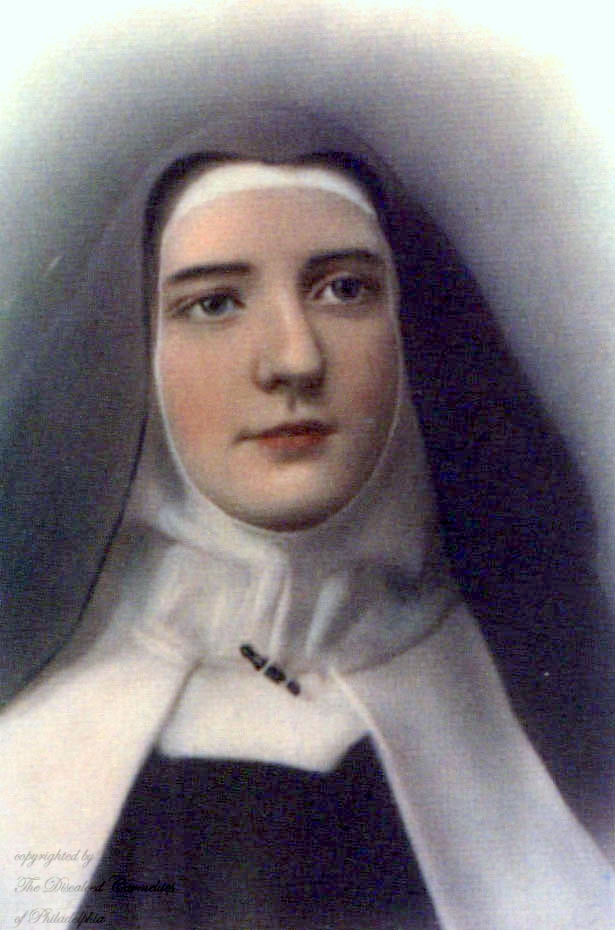 Sister Stanislaus of the Blessed Sacrament, O.C.D.
Sister Stanislaus of the Blessed Sacrament, O.C.D.
Read part one of "Sister Stanislaus of the Blessed Sacrament."
On July 25, 1902, Sister Stanislaus of the Blessed Sacrament rode a train from Boston to her native city, Philadelphia. She was accompanied by two other young women from Philadelphia who, like her, had been parishioners at the Church of the Gesu and were educated by the Sisters of Notre Dame de Namur: Sister Mary of St. Joseph and Sister Xavier of the Angels. With them was their new prioress, Mother Gertrude of the Heart of Jesus, who came from a family in New York City, but she had been educated at the Academy of the Holy Child at Sharon Hill in the Philadelphia suburbs. These four young women came to be known as "the four foundresses." Mother Beatrix of the Holy Spirit, prioress of the Boston Carmel,accompanied them to the temporary monastery at 1518 Poplar Street, the fifth Carmel founded in the United States.
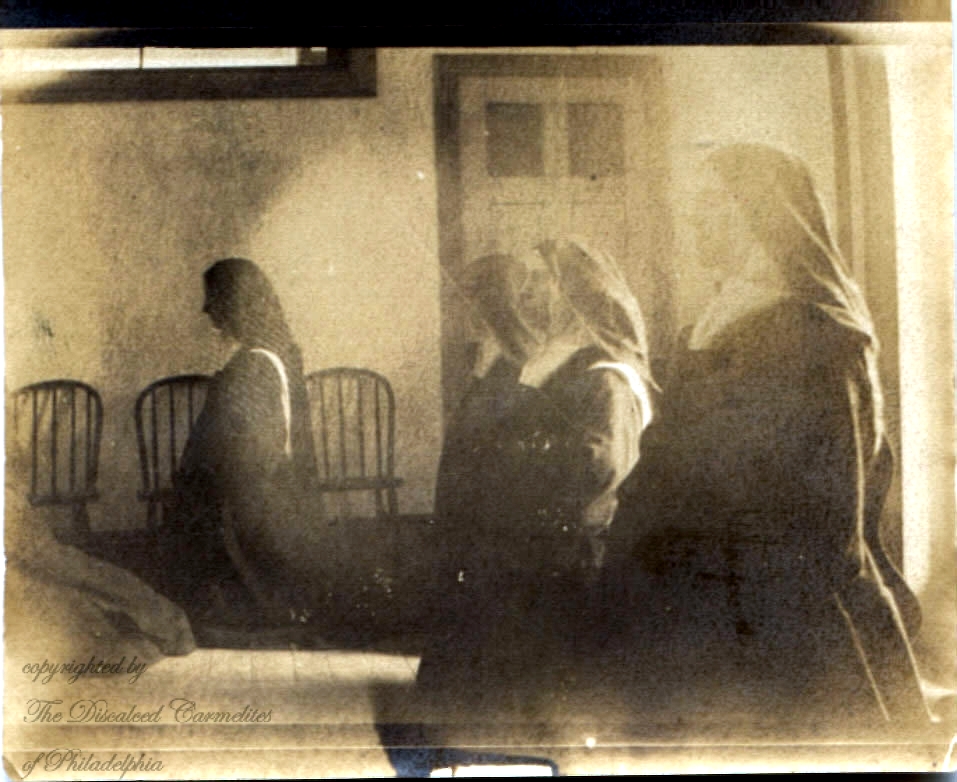 The four foundresses in the chapel of the Poplar Street houseThe next day Archbishop John Patrick Ryan offered the first Mass at the new foundation. For three days, before the enclosure was sealed, the young nuns held "open house" at Poplar Street. Many guests visited, among them the future St. Katharine Drexel and her sister, Louise Morrell; the latter made a generous donation on the spot and contributed generously to the monastery every month for the rest of her long life.
The four foundresses in the chapel of the Poplar Street houseThe next day Archbishop John Patrick Ryan offered the first Mass at the new foundation. For three days, before the enclosure was sealed, the young nuns held "open house" at Poplar Street. Many guests visited, among them the future St. Katharine Drexel and her sister, Louise Morrell; the latter made a generous donation on the spot and contributed generously to the monastery every month for the rest of her long life. 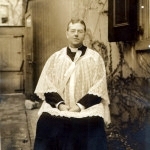 Father John J. Moore, first chaplain of the Philadelphia Carmel
Father John J. Moore, first chaplain of the Philadelphia Carmel
Father John J. Moore was assigned to be the nuns' chaplain. Together with Sister Mary, Sister Stanislaus was assigned as portress, the nun who answered the "turn" and communicated with the faithful seeking prayers, with other guests, and with workmen. The two portresses seized every opportunity to tell the people about St. Therese, then called "The Little Flower." Sister Stanislaus was also infirmarian (nurse) for the little community and was the first "councilor" (nun who advised the prioress). From 1902 she was already in correspondence with St. Therese's sister Pauline (Mother Agnes of Jesus, prioress of the Lisieux Carmel). We may imagine her working hard to spread devotion to St. Therese during the years in which she wrote to Mother Agnes and received the letters described below.
The first letter to Sister Stanislaus from Mother Agnes that survives at Philadelphia is dated May 1, 1903. Mother Agnes refers to the increasing persecution of the Church by the French government and writes that the Lisieux Carmelites expect to be evicted from their monastery, as many other religious communities had been. Mother Agnes mentions that she has been prioress for a year, ever since Mother Gonzague completed two six year-terms "and it was impossible, unfortunately, to re-elect her." She thanks Sister Stanislaus for her account of the good done by rose petals touched to Sister Therese's grave which she had sent to Philadelphia, and says "This is happening everywhere." At this time no proceedings had been opened for Sister Therese; indeed, it was in this year of 1903 that the Scots Father Thomas Taylor, visiting the Lisieux Carmel, was the first to suggest the idea that Sister Therese should be beatified.
The second letter, July 17, 1903, shows that Sister Stanislaus had asked permission to translate and publish a book about St. Therese. Mother Agnes regrets that she can't take the right from her London publishers. She describes the persecution again and rejoices at the graces (of which Sister Stanislaus has told her) being received by the friends of Sister Therese in the United States. Mother Agnes's language suggests that Sister Stanislaus had asked to see the unpublished writings of Sister Therese:
. . . desire no longer to understand pages that you will only be able to read in heaven. Ah, my dear little child, let us write like this: let us leave all the pages of our own lives to be read only in heaven. Do not regret anything. Thérèse will have you taste all of her secrets later on. You will be together forever in the garden of heaven.
In Mother Agnes's third letter, October 9, 1903, she said she has sent to Philadelphia some rose petals touched to the grave of Sister Therese. She expresses her anguish at the illness of Sister Marie of the Eucharist, her cousin Marie Guerin, who is suffering from tuberculosis (though Mother Agnes does not disclose the disease here), and says that the illness had been kept private till now. (Sister Marie of the Eucharist would die in April 1905). She tells Sister Stanislaus where to write for a catalog of French books about St. Therese. Mother Agnes remarks that Sister Genevieve (Celine) has completed the drawing of Therese at the feet of the Holy Father, which will appear in the next edition of Story of a Soul.
On December 8, 1903, Mother Agnes wrote again, promising the prayers of her Carmelites for Mother Gertrude, who is in poor health and for whom Sister Stanislaus is caring. She writes about a pamphlet being printed in English about Sister Therese, which is to be sent to Philadelphia and says that her cousin, Sister Marie of the Eucharist, is better.
On November 23, 1904, the Philadelphia Carmel moves to a larger temporary home on the southwest corner of 44st and Spruce Streets. During the Christmas holidays, on December 29, 1904, Mother Agnes writes again, sending the account of the life of Mother Marie de Gonzague, Therese's prioress, who had just died on December 17, 1904. Mother Agnes adds "let us not be saddened too much over the death of saints." She reports that Sister Marie of the Eucharist (Marie Guerin) is stil very ill.
No letters survive from 1905. On January 6, 1906, Mother Agnes writes to Mother Gertrude in answer to a letter from Mother Gertrude. She refers again to the rising persecutions. The French government was inventorying the property of religious communities with the intention of seizing it. Mother Agnes thanks Mother Gertrude for telling her about the graces St. Therese has obtained for her and for other members of the Philadelphia Carmel:
“Oh, how this angel loves and blesses your monastery! Rather, it is quite right that she reserve for it her most beautiful roses: love and confidence in God . . . .
Our community is very honored to feel itself so united to your dear ones, my Reverend Mother.”
sister Stanislaus receives a letter Mother Agnes wrote on March 2, 1906. Answering a question from Sister Stanislaus, encourages her “to love holy pleasures.” She says
“I love our Carmel [Philadelphia] very much, my little child, and as I write to you feel as much at ease as if I were speaking to one of my daughters.”
She refers to the increasing persecution in France and to how much God is offended. Mother Agnes informs Sister Stanislaus that the Holy Father (Pius X) attached many indulgences to an image of the Holy Face painted by Celine (Sister Genevieve) and attached an indulgence to a prayer to the Holy Face written by St. Therese. She says that the image and the prayer will be included in the 1906 edition of Story of a Soul.
Mother Agnes wrote again on August 8, 1906. Sister Stanislaus, now aged 27, was ill at the time. She worked very hard, once trying to fulfill her duties with a temperature of 103. Mother Agnes expressed sympathy.
My dear little Sister and child, let us always live well-united in Jesus and let us not cease to abandon ourselves to Him. Let us trust His Heart; this touches Him and so inclines Him to give us all that His Divine Heart contains. Oh, then how rich we shall be! How many roses to sprinkle over all the earth!
Mother Agnes’s postscript refers to a visit from Miss Pauline Wilcox, a writer, a friend and benefactor of the Philadelphia Carmel who had visited Lisieux in this year of 1906.
On December 12, 1906, Mother Agnes wrote Sister Stanislaus reporting that on that day the public chapel of the Carmel has been closed. The notes state:
2 During the storm of persecution, The Bishop of Bayeux ordered the closing of the chapels of all monasteries in his Diocese during the week of December 9. The Carmel of Lisieux, however, remained where it was and the religious were never required to leave. The public chapel of the Carmel was re-opened in 1907.
Mother Agnes does not know much longer the French government will allow the nuns to remain at Lisieux, and she asks Sister Stanislaus to address her letters to Isidore Guerin, the uncle of the Martin sisters, at Lisieux. She mentions the possibility of the community’s leaving in April 1907. She encloses a souvenir of a “blessed martyr” (perhaps a holy card, unknown) and speaks of the beautiful celebrations that have taken place in the Carmel’s chapel. (These could have been for December 8, Feast of the Immaculate Conception, or perhaps for October 15 for St. Teresa of Avila). Mother Agnes regrets that “they were the last ones, alas, for a long time” (now that the chapel is closed to the public).
Mother Agnes encloses a poem she herself has written “in reparation” and says it is being sold at Paris. She encloses an image of “The Flight into Egypt” with a poem by Therese. (We do not know which poem).
No letters from Mother Agnes to Sister Stanislaus survive from 1907 or 1908. But on January 4, 1909, Mother Agnes writes to Sister Stanislaus a letter of spiritual counsel:
Do not say that you are far from walking in the path of childhood, because you are walking there; I assure you of it in the name of Thérèse. Let your little heart of a child, therefore, be all joy and confidence! Do not tremble over your miseries; sing rather the mercies of a God Who made you and gives you such great graces each day.
Continue to part three of this series, "Letters from St. Therese's Sister Pauline, Mother Agnes of Jesus, to Sister Stanislaus of the Blessed Sacrament, 'Philadelphia's Little Flower' - Part 3, 1909-1911." This third part highlights the last six letters Sister Stanislaus received from Mother Agnes. She would have received the last, written February 5, 1911, less than a month before her death on March 10, 1911.
I thank the Discalced Carmelite nuns of Philadelphia for sharing this correspondence with us and for the use of their booklet Carmel in Philadelphia: The First Hundred Years (2002).